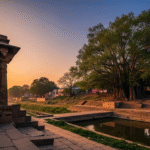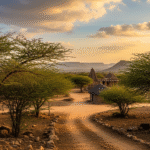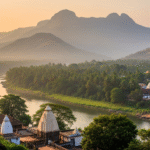Did you know Buddhism is followed by over 500 million people today? This all started with a special moment in Bodh Gaya. Here, Siddhartha Gautama became fully enlightened over 2,500 years ago.
Bodh Gaya is very important to Buddhists. It shows us a deep spiritual journey that mixes history with today’s world. It’s a place where people from everywhere can learn about Bodh Gaya’s past. Ancient ruins and holy temples share the story of enlightenment.
Key Takeaways
- Bodh Gaya is recognized as the birthplace of Buddhism.
- Siddhartha Gautama reached enlightenment here, marking a pivotal moment in history.
- The site houses the Great Mahabodhi Temple, a UNESCO World Heritage site.
- Bodh Gaya has attracted millions of pilgrims and tourists seeking spiritual experiences.
- The area’s rich cultural history includes influences from various dynasties.
- Modern Bodh Gaya continues to serve as a center for Buddhist teachings.
- Legends and myths surrounding the site add layers to its captivating past.
An Introduction to Bodh Gaya: A Spiritual Haven
Bodh Gaya is in Bihar, India. It is a special place for many people who seek peace. This area is known worldwide and is important to Buddhists.
The Mahabodhi Temple is at Bodh Gaya’s center. It is a beautiful and important place for thinking and peace. People come to see its beauty and feel calm.
Green surroundings make Bodh Gaya more peaceful. Many visitors come every year. They help the local shops and hotels. This place mixes old ways with new growth.
Bodh Gaya is a place of peace and togetherness. It welcomes everyone looking to find peace inside themselves.
Bodh Gaya’s Historical Significance
Bodh Gaya is a key place in spiritual history. It is known for its deep Buddhism ties. This holy city tells tales of enlightenment and big changes. Many people visit each year. They come to uncover the Bodh Gaya historical secrets. These secrets show it as the birthplace of Buddhism.
The Birthplace of Buddhism
Bodh Gaya is special because it’s where Buddhism started. Here, Siddhartha Gautama became the Buddha after reaching enlightenment. This happened under the Bodhi Tree around the 5th century BCE. It led to a new spiritual way that spread worldwide.
The city is now a place of pilgrimage. Devotees come to meditate and reflect. They follow the Buddha’s steps.
Connection to Siddhartha Gautama
Bodh Gaya and Siddhartha Gautama share a deep bond. The Mahabodhi Temple, recognized by UNESCO, highlights this moment. Its design shows the evolution of Buddhist architecture. It stands near the original Bodhi Tree. This tree provides a quiet place for deep thought.
Visitors see the blend of Bodh Gaya historical secrets and Buddha’s life. They explore the temple’s grounds.
Ancient ruins and writings around Gaya offer more history. Local markets add to the spiritual feel. Here, visitors enjoy local food and experience Indian traditions.
Learn more about this peaceful spot and its cultural importance at Bodh Gaya’s historical site features.
Uncovering the Unknown History of Bodh Gaya
Exploring Bodh Gaya’s hidden past shows its ancient traditions and incredible stories. This journey starts with old texts about early devotees. These legends show Bodh Gaya’s early importance to many followers.
For centuries, Bodh Gaya saw destruction and rebuilding. These events share stories of resilience and commitment. They highlight how Bodh Gaya became a key place for Buddhism. Scholars help us know more about Bodh Gaya’s history.
Exciting archaeological finds back up these stories. They help us see Bodh Gaya’s rich past. Each discovery tells us about faith and culture together. This work keeps uncovering Bodh Gaya’s powerful role in spirituality and local traditions.
| Aspect | Description |
|---|---|
| Ancient Texts | References to early practices by devotees. |
| Legends | Stories indicating spiritual significance before widespread recognition. |
| Archaeological Discoveries | Artifacts validating historical connections to Buddhism. |
| Cultural Influences | Interplay between spiritual and cultural evolution over centuries. |
| Community Identity | Bodh Gaya’s role in shaping local traditions and practices. |
Studying Bodh Gaya’s unknown past helps us see how it’s a sacred place through time. It shows the faith and wins of many generations.
The Great Mahabodhi Temple: A Symbol of Enlightenment
The Mahabodhi Temple is important in Bodh Gaya. It’s a UNESCO World Heritage Site. This place shows where Siddhartha Gautama found enlightenment and became the Buddha. Its beautiful Bodh Gaya architecture mixes Indian and Nepalese styles. This makes it a peaceful and holy space.
Architecture and Symbolism
The temple has a tall central tower that is about 50 meters high. This tower connects the earth to the divine. The Mahabodhi Temple has detailed carvings that tell about Buddha’s life. They help us understand his wise teachings. People feel peaceful and think deeply when they visit.
Significant Renovations Over Time
In Bodh Gaya, the Mahabodhi Temple has been fixed up many times. The most important work was done in the 19th century, during British rule. These fixes brought back its beauty. They make it a key place for pilgrims from all over the world. Today, taking care of this historic temple means keeping it both beautiful and open for everyone.

This temple is also where many celebrate Buddha Purnima. It is an important place for those looking for spiritual growth and time to think.
| Feature | Description |
|---|---|
| Height of Central Tower | 50 meters |
| UNESCO World Heritage Status | Designated for its cultural significance |
| Architectural Style | Blend of Indian and Nepalese |
| Historical Renovation Period | 19th Century |
Hidden Facts About Bodh Gaya
Bodh Gaya is packed with secrets that make it special for visitors. Its ancient paths tell the story of Buddhism growing far and wide. These paths link together different spiritual practices, showing their deep history.
Ancient Pilgrimage Routes
These old routes show how important Bodh Gaya has been for Buddhism. At first, it was a stop for travelers heading to places like Lumbini and Varanasi. After the Buddha left us, Bodh Gaya quickly became a key place for worship.
Nowadays, pilgrims walk these paths just like people did in the past. They come with deep respect, making the place feel alive with spirituality.
Legacy of Buddha’s Teachings
The teachings of Buddha live on, not just in Bodh Gaya but around the world. These ideas have shaped many different practices and rituals. Bodh Gaya’s early importance helped it become known globally in Buddhism.
In places like China and Japan, important pilgrimage sites also reflect Buddha’s impact. Travelers to these places often feel changed. They connect with the vast history that started in Bodh Gaya.
Bodh Gaya’s Mysterious Past: Legends and Myths
Bodh Gaya’s history is full of legends and myths. These stories show its deep spiritual importance. They touch the hearts of everyone who comes here.
Stories of Enlightenment
The tales of Siddhartha Gautama’s enlightenment inspire many. They include magical moments and divine help. Stories tell how meditation changed Siddhartha into the Buddha.
Local stories add to these legends. They compare Siddhartha’s journey to those looking for spiritual answers in Bodh Gaya today.
Spiritual Experiences Shared by Visitors
Many say visiting Bodh Gaya changed their lives. They talk about finding peace under the Bodhi Tree. This is where Siddhartha became enlightened.
People also share stories of spiritual awakenings. They feel a strong bond with everything around them. Such experiences show why Bodh Gaya is special for those on a spiritual quest.

Bodh Gaya’s Enigmatic Origins: A Cultural Tapestry
Bodh Gaya’s history shows a rich mix of cultures. Different rulers over time added their own traditions. This blend of beliefs makes Bodh Gaya interesting for visitors and scholars.
Influence of Various Dynasties
Many dynasties, like the Mauryans and Guptas, shaped Bodh Gaya. They brought new buildings, practices, and social ways. This mix tells a story of Bodh Gaya’s deep spiritual meaning.
Intermingling of Faiths and Practices
Bodh Gaya is a mix of Buddhism, Hinduism, and Jainism. This blend creates a special spiritual feel. People say it’s a place where different beliefs meet peacefully.
This cultural mix influences local art and beliefs. Temples and monuments show Bodh Gaya’s diverse history. They remind us of its special place in India’s spiritual journey.
Exploring the Buried History of Bodh Gaya
Bodh Gaya’s hidden depths offer exciting stories through big archaeological finds. These discoveries teach us more about this special place. They show us old buildings and objects. This tells us how people lived, prayed, and grew as a community here.
Archaeological Discoveries
One big find in Bodh Gaya is the Mahabodhi Temple. It is a very old Buddhist temple made of bricks. It dates back to the fifth or sixth century CE. It is more than 55 meters tall. The Bihar Heritage Development Society found something big under it using special cameras from the sky. They saw a big square monastery hidden below. This place has a large outer square and a smaller inner square. They think it has more important buildings. They could be related to other famous places like the Sujata Stupa.
Preservation Efforts and Challenges
Protecting Bodh Gaya’s finds is hard. Pollution and many visitors can damage these old places. We need new ways to keep the Mahabodhi Temple safe from harm. Groups like the Bihar Heritage Development Society and Cardiff University are working together. They want to find the best ways to protect these special spots. Using ground radars and careful digging, they hope to keep Bodh Gaya’s history safe for everyone.
Conclusion
Bodh Gaya has a secret history that is very interesting. It is known as a special place for people who want to find peace. This place is important because it is where Buddhism started.
Many people visit it each year to learn and feel connected to something big. When we learn about its past, we feel close to everyone who has been there before us. It helps us understand big ideas about life and how we all are connected.
Knowing about Bodh Gaya makes us see the world differently. It helps us grow by thinking about our lives in new ways. The stories from Bodh Gaya teach us things that are important even today.
We need to keep learning about Bodh Gaya for young people in the future. This place teaches us about searching for truth and wanting to make things better. Its history can help us deal with hard things and make us feel like we belong to a bigger story.
FAQ
What is Bodh Gaya known for?
Bodh Gaya is famous for being the place where Siddhartha Gautama found enlightenment. It’s a UNESCO World Heritage site and draws millions of Buddhists.
Why is the Mahabodhi Temple significant?
The Mahabodhi Temple shows what enlightenment looks like. It’s a key part of Bodh Gaya’s sacred feel. Its style is a mix of Indian and Nepalese, kept up through many fix-ups.
What are some hidden facts about Bodh Gaya?
Bodh Gaya hides facts like old routes for pilgrims that show how Buddhism spread from India. Buddha’s teachings keep influencing cultures and people everywhere.
What mysteries surround Bodh Gaya’s historical past?
Mysteries of Bodh Gaya include legends about Siddhartha’s enlightenment. Stories and folklore make the place more magical, affecting many visitors spiritually.
How has Bodh Gaya’s cultural origins influenced its history?
Bodh Gaya’s culture comes from many dynasties, like the Mauryans and Guptas. This mix of beliefs and practices makes its spiritual air special.
Are there any archaeological discoveries in Bodh Gaya?
Yes, Bodh Gaya’s digs have found old objects. These finds tell us about the past religion and life of its people.
What challenges does Bodh Gaya face regarding preservation?
Bodh Gaya struggles with keeping itself safe from pollution and too many visitors. New plans are needed to save its culture and history while welcoming tourists.










